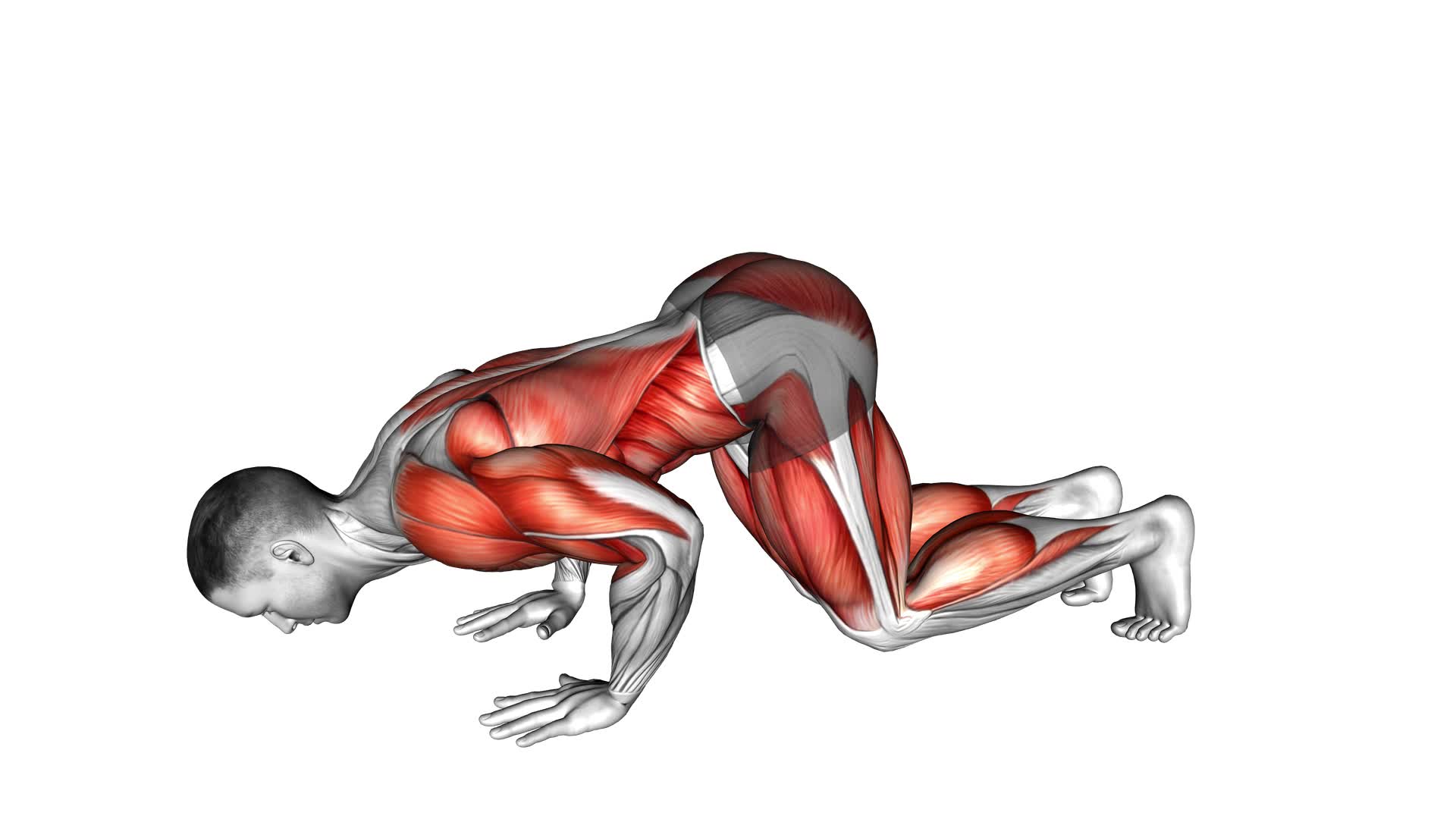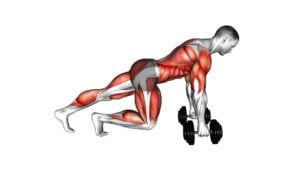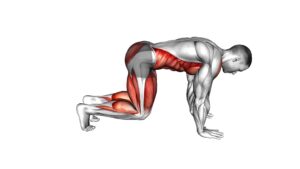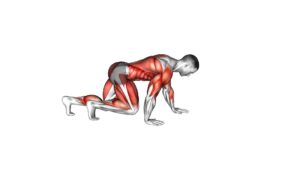Bear Push-up (male) – Video Exercise Guide & Tips

Are you looking to strengthen your upper body and core muscles? Look no further than the bear push-up.
Watch This Exercise Video
In this video exercise guide, we'll show you proper form and technique for this challenging exercise. Whether you're a beginner or advanced, we have modifications to suit your fitness level.
Avoiding common mistakes and incorporating these push-ups into your routine will help you increase intensity and achieve your fitness goals.
Get ready to bear down and get stronger!
Key Takeaways
- Bear push-ups improve core strength and upper body strength.
- Bear push-ups target multiple muscle groups simultaneously, including the chest, shoulders, triceps, and abs.
- Bear push-ups enhance posture, overall stability, and cardiovascular endurance.
- Bear push-ups can be modified for beginners and advanced individuals, and can be made more challenging by elevating the feet, adding resistance bands, or performing single-leg variations.
Benefits of Bear Push-ups (male)
Get ready to discover the amazing benefits of bear push-ups for males.
Bear push-ups are an effective exercise for improving core strength and increasing upper body strength. By performing bear push-ups regularly, you can target multiple muscle groups simultaneously, including your chest, shoulders, triceps, and abs.
One of the key benefits of bear push-ups is the improvement in core strength. As you lower your body towards the ground and then push back up, your core muscles, including your abdominals and lower back, are engaged to stabilize your body. This helps to strengthen and tone your core, leading to better posture and overall stability.
In addition to core strength, bear push-ups also help to increase upper body strength. As you lower your body down and push back up, your chest, shoulders, and triceps are activated. This leads to stronger and more defined muscles in these areas, enhancing your overall upper body strength.
To maximize the benefits of bear push-ups, it's important to maintain proper form and technique. Transitioning into the subsequent section, let's explore the correct form and technique to perform bear push-ups effectively and safely.
Proper Form and Technique
To perform bear push-ups with proper form and technique, you need to position yourself in a plank position with your hands and feet on the ground. This exercise is highly effective for strengthening your muscles and improving your overall fitness level.
One key aspect of bear push-ups is the importance of core engagement. As you lower your body towards the ground, focus on contracting your abdominal muscles to maintain stability and control. This won't only protect your lower back, but also enhance the effectiveness of the exercise.
Another crucial element to consider is your breathing technique during bear push-ups. It's recommended to inhale deeply as you lower your body towards the ground, and exhale forcefully as you push back up. This controlled breathing pattern helps to oxygenate your muscles and maintain a steady rhythm throughout the exercise. By synchronizing your breath with your movements, you can enhance your performance and maximize the benefits of the bear push-up.
Mastering proper form and technique is essential when performing bear push-ups. By engaging your core and utilizing the correct breathing techniques, you can ensure that you're getting the most out of this exercise. Remember to maintain a steady pace and listen to your body, making adjustments as needed. With consistent practice, you'll soon see improvements in your strength and endurance.
Modifications for Beginners and Advanced
For beginners and advanced individuals, there are several modifications you can incorporate into your bear push-up routine to challenge yourself and tailor the exercise to your fitness level.
If you're a beginner, start by performing modified bear push-ups on your knees instead of your toes. This will reduce the amount of weight you have to lift and make the exercise more manageable. As you gain strength and confidence, you can gradually progress to performing bear push-ups on your toes.
For advanced modifications, you can try adding a leg lift to the bear push-up. As you lower your body towards the ground, lift one leg off the floor and extend it behind you. This will engage your core and challenge your stability even further. Another advanced modification is to perform the bear push-up with your feet elevated on a stable surface, such as a bench or step. This will increase the difficulty and further engage your upper body muscles.
By incorporating these beginner and advanced modifications into your bear push-up routine, you can continuously challenge yourself and make progress towards your fitness goals.
Now, let's move on to the next section and discuss the common mistakes to avoid in order to perform the bear push-up effectively and safely.
Common Mistakes to Avoid
In the article titled 'Bear Push-up (male) – Video Exercise Guide & Tips {752712}', let's now focus on the common mistakes to avoid when performing this exercise. By being aware of these mistakes, you can ensure that you perform the bear push-up correctly and effectively, while avoiding injuries and maximizing muscle activation.
One common mistake to avoid is allowing your lower back to sag during the exercise. This can put excessive strain on your spine and increase the risk of injury. To prevent this, engage your core muscles and maintain a straight line from your head to your heels throughout the movement.
Another mistake to avoid is rushing through the exercise. Performing the bear push-up too quickly can compromise form and reduce muscle activation. Instead, focus on executing each rep with control and proper technique.
Additionally, avoid placing too much weight on your shoulders and wrists. Distribute your weight evenly between your hands and knees to prevent excessive strain on these joints.
Tips for Increasing Intensity
Looking to make the bear push-up more challenging? Here are some ways to increase the intensity and progress in your bear push-ups:
- Elevate your feet: By placing your feet on an elevated surface, such as a step or a bench, you increase the load on your upper body. This engages your chest, shoulders, and triceps even more, making the exercise more challenging.
- Add a resistance band: Wrap a resistance band around your back and hold the ends in your hands while performing the bear push-up. The band provides additional resistance, forcing your muscles to work harder and helping you build strength.
- Try single-leg bear push-ups: Instead of having both feet on the ground, lift one leg off the floor while performing the push-up. This asymmetrical stance increases the demand on your core and upper body, making the exercise more challenging and improving your stability.
By implementing these tips, you can take your bear push-ups to the next level and continue to progress in your training.
Remember to start with proper form and gradually increase the difficulty as you get stronger. Stay consistent and challenge yourself, and you'll see improvements in your strength and overall fitness.
Incorporating Bear Push-Ups Into Your Workout Routine
To incorporate bear push-ups into your workout routine, consider adding them as a compound exercise to target multiple muscle groups simultaneously. Bear push-ups are a variation of the traditional push-up that incorporates animal movements, making it a challenging and dynamic exercise. By incorporating bear push-ups into your routine, you can increase the intensity of your workout and engage different muscle groups in your upper body, core, and lower body.
One way to incorporate bear push-ups is to include them in a circuit training routine. You can perform a set of bear push-ups followed by other exercises such as squats, lunges, or planks. This won't only help you build strength but also improve your cardiovascular endurance.
Another option is to use bear push-ups as a warm-up exercise before your main workout. This can help activate your muscles and prepare them for more intense movements. Additionally, bear push-ups can be included as part of a full-body workout routine, where you alternate between upper body, lower body, and core exercises.
Remember to start with the basic bear push-up variation and gradually progress to more challenging variations as you build strength and stability. Incorporating bear push-ups into your workout routine can add variety and challenge to your training, helping you achieve your fitness goals.
Frequently Asked Questions
How Many Calories Does the Bear Push-Up (Male) Exercise Burn?
The bear push-up exercise is a great way to burn calories and improve upper body strength. By incorporating bear push-up variations into your workout routine, you can challenge different muscle groups and increase the intensity of your workouts.
This exercise targets your chest, shoulders, triceps, and core muscles, helping you build strength and definition.
As for the exact number of calories burned, it depends on factors such as your weight, intensity, and duration of the exercise.
Can Bear Push-Ups Help in Strengthening the Core Muscles?
Incorporating bear push-ups into your daily workout routine can provide numerous benefits for strengthening your core muscles. This exercise engages your abs, lower back, and glutes, helping to improve stability and overall strength.
Additionally, bear push-ups can be modified to suit different fitness levels. Beginners can start with knee variations, while advanced individuals can try adding a leg lift or a push-up at the end of each rep.
Remember to always maintain proper form and gradually increase intensity to avoid injury.
Are There Any Specific Breathing Techniques to Be Followed During Bear Push-Ups?
During bear push-ups, it's important to focus on your breathing techniques to maintain proper form and maximize the benefits. Take a deep breath in as you lower your body towards the ground, and exhale as you push yourself back up. This helps engage your core muscles and maintain stability throughout the exercise.
Additionally, if you have wrist injuries, you can modify this exercise by using dumbbells or push-up handles to alleviate pressure on your wrists.
Can Bear Push-Ups Be Performed by Individuals With Wrist Injuries?
If you have wrist injuries, bear push-ups may not be suitable for you. It's important to prioritize your safety and avoid further damage.
Fortunately, there are bear push-up modifications you can try to reduce the strain on your wrists.
Alternatively, you can explore alternative exercises that target similar muscle groups without putting pressure on your wrists.
Consulting with a fitness professional or physical therapist can help you find the best options for your specific situation.
How Long Should One Rest Between Sets of Bear Push-Ups?
To maximize your results, it's important to know how long to rest between sets of bear push-ups. The rest duration can vary depending on your fitness level and goals.
Generally, a rest period of 30-60 seconds is recommended to allow your muscles to recover and recharge. However, you can also experiment with shorter or longer rest periods to challenge yourself and add variation to your workout routine.
Remember to listen to your body and adjust accordingly.
Conclusion
Incorporating bear push-ups into your workout routine can be beneficial for males. They help strengthen the upper body, core, and improve overall stability. By maintaining proper form and technique, you can maximize the effectiveness of this exercise.
Beginners can modify by starting on their knees, while advanced individuals can challenge themselves with variations like single-leg bear push-ups. Avoid common mistakes like sagging hips or not maintaining a neutral spine.
Increase intensity by adding a resistance band or performing more repetitions.

Author
Years ago, the spark of my life’s passion ignited in my mind the moment I stepped into the local gym for the first time. The inaugural bead of perspiration, the initial endeavor, the very first surge of endorphins, and a sense of pride that washed over me post-workout marked the beginning of my deep-seated interest in strength sports, fitness, and sports nutrition. This very curiosity blossomed rapidly into a profound fascination, propelling me to earn a Master’s degree in Physical Education from the Academy of Physical Education in Krakow, followed by a Sports Manager diploma from the Jagiellonian University. My journey of growth led me to gain more specialized qualifications, such as being a certified personal trainer with a focus on sports dietetics, a lifeguard, and an instructor for wellness and corrective gymnastics. Theoretical knowledge paired seamlessly with practical experience, reinforcing my belief that the transformation of individuals under my guidance was also a reflection of my personal growth. This belief holds true even today. Each day, I strive to push the boundaries and explore new realms. These realms gently elevate me to greater heights. The unique combination of passion for my field and the continuous quest for growth fuels my drive to break new ground.







